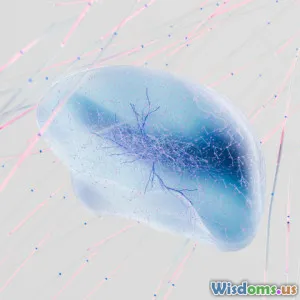
What Happens in Your Brain When You Have a Nightmare
10 min read Discover the brain science behind nightmares and how your brain reacts during these vivid, unsettling dreams. (0 Reviews)
What Happens in Your Brain When You Have a Nightmare
Nightmares have haunted human experience for centuries—those intense, often terrifying dreams that jolt us awake in terror, leaving lingering unease. But what exactly occurs in your brain during these distressing nocturnal episodes? Beyond the chilling images and sensations lies a fascinating neurological ballet that unravels how our brains process fear, memory, and emotion while we sleep.
Understanding the science behind nightmares not only illuminates the shadowy corners of our dreaming mind but offers insights into disorders, mental health, and how we might better manage sleep quality. This article delves deep into the neuroscience of nightmares, unpacking the brain mechanisms that generate these fearful dreams and what they reveal about our emotional states.
The Foundation of Dreaming: What Is a Nightmare?
Before we explore the brain during nightmares, it’s important to define what constitutes these disturbing dreams. Nightmares are vivid dreams—usually occurring during the Rapid Eye Movement (REM) stage of sleep—that evoke fear, anxiety, or sadness. Unlike night terrors, which are more common in children and involve physical panic without detailed memories, nightmares can be vividly recalled.
According to the American Academy of Sleep Medicine, nightmares often awaken the sleeper due to their distressing nature and can result in difficulty falling back asleep.
How Sleep Architecture Sets the Stage
Sleep alternates between non-REM and REM stages in approximately 90-minute cycles. REM sleep, which constitutes about 20-25% of adult sleep time, is when most vivid dreaming occurs. This stage is characterized by increased brain activity in areas implicated in emotion, memory, and sensory processing.
Studies using functional magnetic resonance imaging (fMRI) and positron emission tomography (PET) scans have revealed that the amygdala, hippocampus, and visual cortices are highly active during REM sleep. The amygdala, known as the brain’s emotional alarm center, plays a pivotal role in processing fear and threat detection.
The Amygdala: The Emotional Epicenter
During a nightmare, the amygdala exhibits heightened activation compared to non-disturbing dreams. This surge amplifies feelings of fear and anxiety. Neuroscientist Dr. Tore Nielsen notes in his research that amygdala hyperactivity during REM sleep mirrors brain responses during waking fear, suggesting nightmares are an overlapping experience of emotional processing.
For example, people with post-traumatic stress disorder (PTSD) often exhibit exaggerated amygdala responses during nightmares, reflecting re-experiences of trauma that replay emotionally charged memories.
The Prefrontal Cortex: A Power Struggle of Control
Conversely, the prefrontal cortex—responsible for rational thought, decision-making, and self-control—is paradoxically less active during REM sleep. This decreased activity explains why dream logic is often illogical and why we accept bizarre or frightening scenarios without question.
In nightmares, the diminished suppression from the prefrontal cortex allows the amygdala's fear signals to dominate, leaving the dreamer emotionally overwhelmed and without the usual checks and balances of waking cognition. This imbalance partly accounts for why nightmares feel so uncontrollable and intense.
The Hippocampus: Memory’s Role in Nightmare Content
The hippocampus is central to forming and retrieving memories. Nightmares often have roots in real-life experiences, particularly those involving trauma or stress. The interaction between the hippocampus and amygdala helps embed emotional memories, which may need processing during sleep.
A 2016 study in the journal Current Biology demonstrated that disrupted hippocampal activity during sleep can enhance the vividness and emotional charge of dreams. This mechanism explains why past negative events, anxieties, or fears sometimes replay in nightmares.
Neurochemistry: The Role of Neurotransmitters
Brain chemicals also influence nightmares. During REM sleep, neurotransmitters like acetylcholine rise while serotonin and norepinephrine decline. The low norepinephrine (associated with alertness and fight-or-flight) may affect memory consolidation but also reduce waking-like control, facilitating vivid dream imagery.
Interestingly, antidepressants influencing serotonin or norepinephrine pathways can alter nightmare frequency or intensity. For instance, SSRIs (Selective Serotonin Reuptake Inhibitors) sometimes worsen nightmares initially, whereas prazosin, which blocks norepinephrine receptors, has been effective in reducing PTSD-related nightmares.
Why Do Nightmares Persist? Theories from Brain Science
Several theories attempt to explain why the brain generates nightmares:
-
Threat Simulation Theory: Proposed by cognitive neuroscientist Antti Revonsuo, this idea suggests nightmares act as an ancient evolutionary function to simulate threatening scenarios, preparing us mentally for dangers.
-
Emotional Regulation Hypothesis: Nightmares may serve to process unresolved emotions or stressors. The brain uses REM sleep to integrate emotional experiences and attempt to 'extinguish' fear memories.
-
Memory Consolidation Disruption: Anomalies in hippocampal-prefrontal-amygdala circuits during sleep might distort the normally adaptive processing, creating nightmares instead of neutral or pleasant dreams.
Real-World Impact: Nightmares and Mental Health
Chronic nightmares affect 2-8% of adults and are commonly associated with psychiatric conditions like PTSD, depression, and anxiety disorders. Beyond distressing nocturnal experiences, repeated nightmares can lead to fragmented sleep, excessive daytime fatigue, and emotional dysfunction.
A 2018 study published in Sleep Medicine Reviews highlighted that nightmare frequency correlated with higher rates of suicidality, underscoring the importance of recognizing and treating pathological nightmares.
Treatments Targeting Brain Mechanisms
Therapies aimed at reducing nightmares tap into our understanding of brain functions:
-
Imagery Rehearsal Therapy (IRT): Patients rewrite the narrative of recurring nightmares during waking hours, which helps reduce amygdala hyperactivity during sleep.
-
Pharmacological Approaches: Drugs like prazosin modulate noradrenergic activity, reducing the intensity and frequency of nightmares.
-
Cognitive Behavioral Therapy (CBT): By addressing conscious thoughts and stress, CBT can indirectly lower nightmare occurrence by reducing overall anxiety.
Conclusion: Unveiling the Midnight Mind
Nightmares are more than nightmares—they represent a complex interplay of brain regions managing fear, memory, and emotion in the vulnerable landscape of sleep. The heightened amygdala activity, subdued prefrontal control, and memory replay by the hippocampus make nightmares intense emotional experiences woven from threads of our waking lives.
Modern brain science not only demystifies these nocturnal terrors but opens avenues to treat and manage nightmare disorders. Understanding what happens inside your brain when you have a nightmare empowers you to approach sleep disturbances with compassion and knowledge, ultimately guiding toward healthier, more restorative nights.
Embrace the marvel of your dreaming brain—it is a window into your deepest fears, but also your pathway to healing and emotional growth.
References
- Nielsen, T., & Levin, R. (2007). Nightmares: a new neurocognitive model. Sleep Medicine Reviews, 11(4), 295-310.
- Revonsuo, A. (2000). The reinterpretation of dreams: An evolutionary hypothesis of the function of dreaming. Behavioral and Brain Sciences, 23(6), 877-901.
- van Liempt, S. et al. (2013). Hallmark of posttraumatic stress disorder is extinction memory impairment. Biological Psychiatry, 73(8), 737-744.
- Krakow, B. et al. (2001). Imagery rehearsal therapy for chronic nightmares in sexual assault survivors with PTSD. Journal of the American Medical Association, 286(5), 537-545.
- Germain, A. et al. (2016). Sleep abnormalities associated with the severity of PTSD and comorbid insomnia. Psychoneuroendocrinology., 43, 78-91.
Images and detailed brain scan data can be further explored in sleep research journals and neuroscience repositories.
Rate the Post
User Reviews
Popular Posts




















